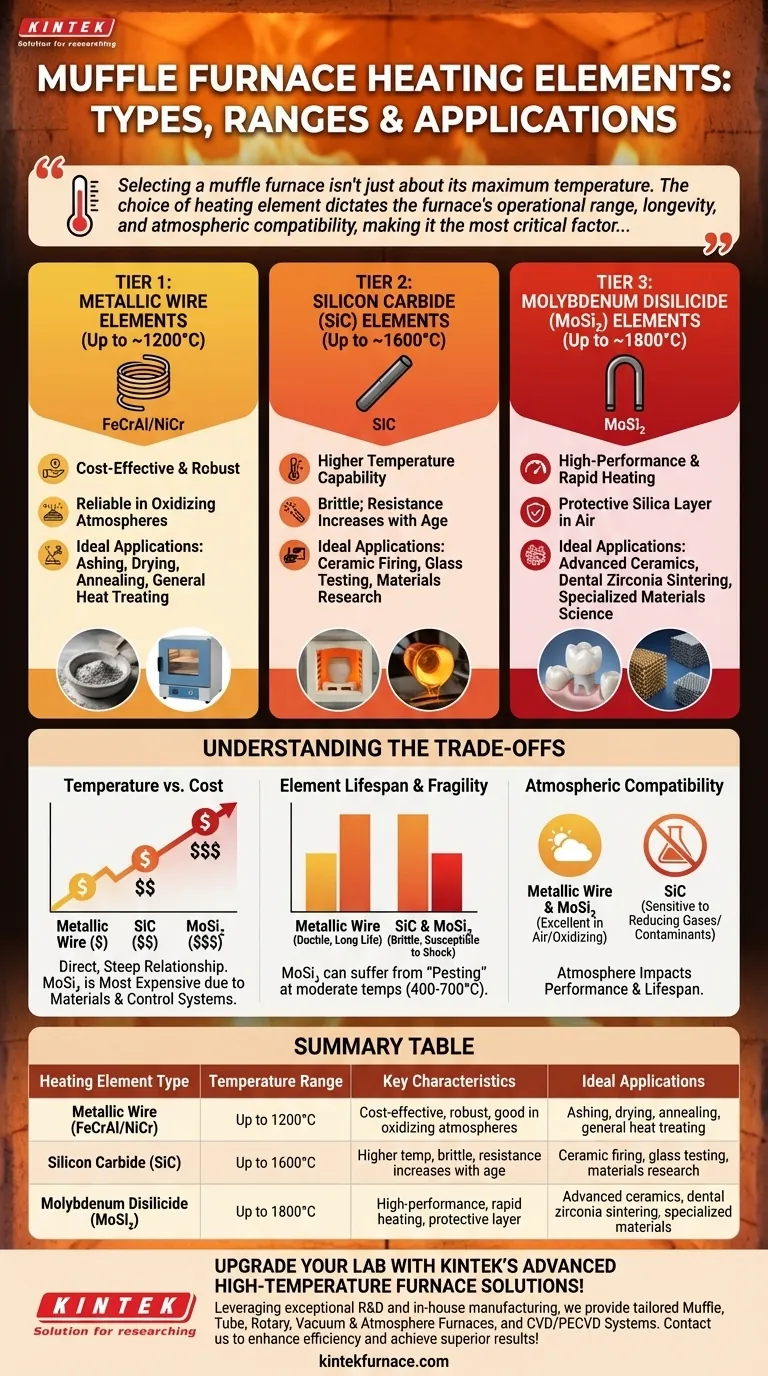The core of a muffle furnace's capability is determined by its heating element. The three primary types are metallic wire elements for general-purpose applications up to 1200°C, silicon carbide (SiC) elements for higher temperatures up to 1600°C, and molybdenum disilicide (MoSi₂) elements for the most demanding processes requiring temperatures up to 1800°C. Each type represents a distinct tier of performance, cost, and operational complexity.
Selecting a muffle furnace isn't just about its maximum temperature. The choice of heating element dictates the furnace's operational range, longevity, and atmospheric compatibility, making it the most critical factor in matching the equipment to your specific scientific or industrial process.
The Three Tiers of Muffle Furnace Heating
The heating element is the engine of your furnace. Understanding the fundamental differences between the three main types is essential for choosing the correct tool and operating it effectively.
Tier 1: Metallic Wire Elements (Up to ~1200°C)
These are the most common and cost-effective heating elements, forming the backbone of standard laboratory and industrial furnaces.
They are typically made from iron-chromium-aluminum (FeCrAl) or nickel-chromium (NiCr) alloys.
These elements are ideal for routine applications such as ashing, drying, annealing, and general heat treating. They are robust, reliable in oxidizing (air) atmospheres, and offer an excellent balance of performance and price for low-to-mid-range temperature work.
Tier 2: Silicon Carbide (SiC) Elements (Up to ~1600°C)
Silicon carbide elements represent the next step up in performance, enabling processes that are impossible with metallic wire.
These rigid, rod-like elements can operate at significantly higher temperatures, making them suitable for some ceramic firing, glass testing, and materials research.
However, SiC elements are more brittle than metallic wire and their electrical resistance increases over time as they age, which may require periodic adjustments to the power supply.
Tier 3: Molybdenum Disilicide (MoSi₂) Elements (Up to ~1800°C)
Often referred to as "silicon molybdenum rods," MoSi₂ elements are the high-performance standard for the most demanding applications.
These U-shaped elements can achieve very high temperatures and support rapid heating rates. This makes them essential for advanced ceramics, dental zirconia sintering, and specialized materials science.
At high temperatures, MoSi₂ elements form a protective glassy layer of silica, which allows them to operate effectively in air.
Understanding the Trade-offs
Choosing an element is not just about temperature. You must weigh performance against cost, longevity, and operational requirements.
Temperature vs. Cost
The relationship is direct and steep. Metallic wire elements are the most affordable, followed by Silicon Carbide, with Molybdenum Disilicide being the most expensive.
This cost difference reflects not only the raw materials but also the complexity of the power control systems required for each element type.
Element Lifespan and Fragility
Metallic wire elements are relatively ductile and resistant to thermal shock, offering a long and predictable service life if kept below their maximum temperature limit.
SiC and MoSi₂ elements, being ceramic-based, are hard but brittle. They are susceptible to damage from mechanical impact or severe thermal shock.
Furthermore, MoSi₂ elements can suffer from a condition known as "pesting"—a rapid oxidative degradation that can occur at moderate temperatures (between 400°C and 700°C). This requires careful operational procedures to move through this temperature range quickly.
Atmospheric Compatibility
The atmosphere inside the furnace has a significant impact on element performance.
Metallic wire and MoSi₂ elements perform exceptionally well in air and other oxidizing atmospheres.
Silicon Carbide can be used in a variety of atmospheres, but its lifespan may be affected by certain reducing gases or contaminants. Using elements outside their specified atmosphere can lead to premature failure.
Matching the Element to Your Application
Your final decision must be guided by your primary operational goal.
- If your primary focus is general lab work below 1200°C (e.g., ashing, annealing): A furnace with metallic wire elements is the most cost-effective and reliable choice.
- If your primary focus is high-temperature processing up to 1600°C (e.g., certain ceramics, glass testing): A furnace with Silicon Carbide (SiC) elements provides the necessary capability, balancing performance and cost.
- If your primary focus is rapid, high-purity processing above 1600°C (e.g., advanced materials research, dental zirconia sintering): A furnace with Molybdenum Disilicide (MoSi₂) elements is essential for its speed and maximum temperature.
Understanding these core differences ensures you invest in a tool that truly serves your long-term technical goals.
Summary Table:
| Heating Element Type | Temperature Range | Key Characteristics | Ideal Applications |
|---|---|---|---|
| Metallic Wire (FeCrAl/NiCr) | Up to 1200°C | Cost-effective, robust, good in oxidizing atmospheres | Ashing, drying, annealing, general heat treating |
| Silicon Carbide (SiC) | Up to 1600°C | Higher temperature capability, brittle, resistance increases with age | Ceramic firing, glass testing, materials research |
| Molybdenum Disilicide (MoSi₂) | Up to 1800°C | High-performance, rapid heating, protective silica layer in air | Advanced ceramics, dental zirconia sintering, specialized materials science |
Upgrade your laboratory with KINTEK's advanced high-temperature furnace solutions! Leveraging exceptional R&D and in-house manufacturing, we provide diverse labs with tailored options like Muffle, Tube, Rotary Furnaces, Vacuum & Atmosphere Furnaces, and CVD/PECVD Systems. With strong deep customization capabilities, we precisely meet your unique experimental needs—whether you're working with metallic wire, silicon carbide, or molybdenum disilicide elements. Contact us today to discuss how our furnaces can enhance your efficiency and achieve superior results!
Visual Guide

Related Products
- Laboratory Muffle Oven Furnace with Bottom Lifting
- 1400℃ Muffle Oven Furnace for Laboratory
- 1700℃ High Temperature Muffle Oven Furnace for Laboratory
- 1800℃ High Temperature Muffle Oven Furnace for Laboratory
- Multi Zone Laboratory Quartz Tube Furnace Tubular Furnace
People Also Ask
- How do you maintain a muffle furnace? Ensure Longevity and Safety with Proven Tips
- How do you prevent maintenance on a muffle furnace? Extend Lifespan with Proactive Care
- What metals cannot be heated by induction? Understanding Material Suitability for Efficient Heating
- What is preventive maintenance on a furnace? A Proactive Strategy for Peak Performance
- How to maintain a heating element? Extend its life and ensure safety with proper care



















